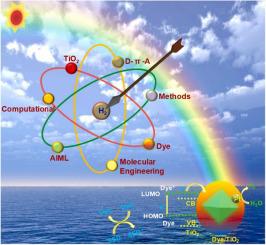Journal of Photochemistry and Photobiology C: Photochemistry Reviews ( IF 13.6 ) Pub Date : 2023-08-16 , DOI: 10.1016/j.jphotochemrev.2023.100621 Spandana Gonuguntla , Reddi Kamesh , Ujjwal Pal , Debabrata Chatterjee

|
Research over dye-sensitized hydrogen generation using TiO2 semiconductor photocatalysts has gained abiding importance over the past three decades due to its manifold advantages over other photocatalytic systems for the production of clean energy fuels. The single-step excitation of the electrons over the sensitizer molecules anchored at the TiO2 semiconductor serves as a driving source to facilitate the electron effect transfers, thus prompting the visible-light driven photocatalytic hydrogen generation activities. Though many review articles that evaluate the performance of such dye-sensitized semiconductor particulate systems are available in the literature, research progress made in the last few years since 2016 is not yet systematically reviewed. In this article, we therefore, systematically review the development of new dye-sensitizers that include metal-free organic dyes, metal-based sensitizers, and donor-bridged-acceptor (D-π-A) type dye-sensitizers, and their performances in sensitization of the TiO2 semiconductor photocatalyst towards visible light driven hydrogen generation through water splitting. It has been chronicled that the aforesaid sensitizers are capable of harvesting a broader part of the solar spectrum, and could achieve photocatalytic H2 production with varying degrees of success. The results discussed in this review afford a significant scope of rationalizating the factors that govern the H2 production activity over the dye-modified TiO2 photocatalyst, and provide a basis for further research towards the realization of high-performing dye-sensitized H2 production photocatalytic system. The prospect of artificial intelligence (AI)-machine learning (ML) based modeling for quicker design and development of dye-sensitized TiO2 based photocatalytic solar to fuel conversion system has been briefly discussed in the article.
中文翻译:

与光催化制氢相关的TiO2染料敏化:当前研究趋势和前景
使用TiO 2半导体光催化剂进行染料敏化制氢的研究在过去三十年中获得了持久的重要性,因为它比其他用于生产清洁能源燃料的光催化系统具有多种优势。固定在 TiO 2上的敏化剂分子上的电子的单步激发半导体作为驱动源促进电子效应转移,从而促进可见光驱动的光催化制氢活动。尽管文献中已有许多评估此类染料敏化半导体颗粒系统性能的综述文章,但自 2016 年以来最近几年的研究进展尚未得到系统综述。因此,在本文中,我们系统地回顾了新型染料敏化剂的开发,包括无金属有机染料、金属基敏化剂和供体桥受体(D-π-A)型染料敏化剂及其性能TiO 2的敏化半导体光催化剂通过水分解实现可见光驱动氢的产生。据记载,上述敏化剂能够捕获更广泛的太阳光谱,并且可以不同程度地成功地实现光催化H 2生产。本综述讨论的结果在很大程度上合理化了染料改性 TiO 2光催化剂的 H 2生产活性的影响因素,并为进一步研究实现高性能染料敏化 H 2提供了基础。生产光催化系统。本文简要讨论了基于人工智能 (AI)-机器学习 (ML) 的建模对于更快地设计和开发基于染料敏化 TiO 2的光催化太阳能到燃料转换系统的前景。



























 京公网安备 11010802027423号
京公网安备 11010802027423号